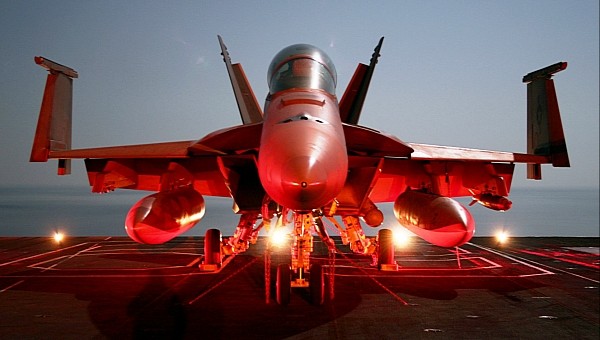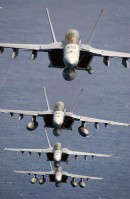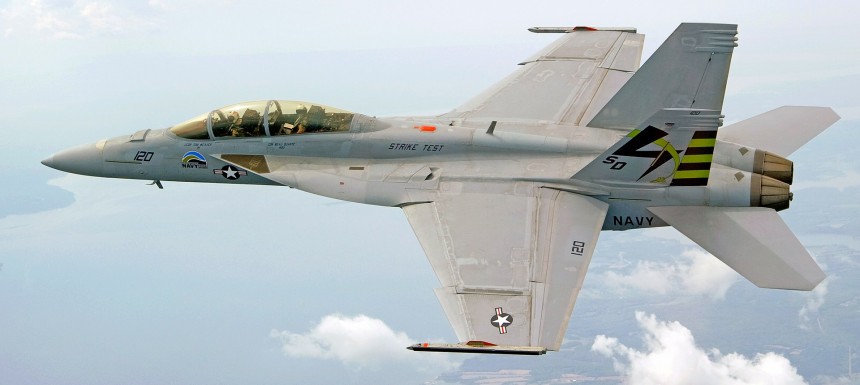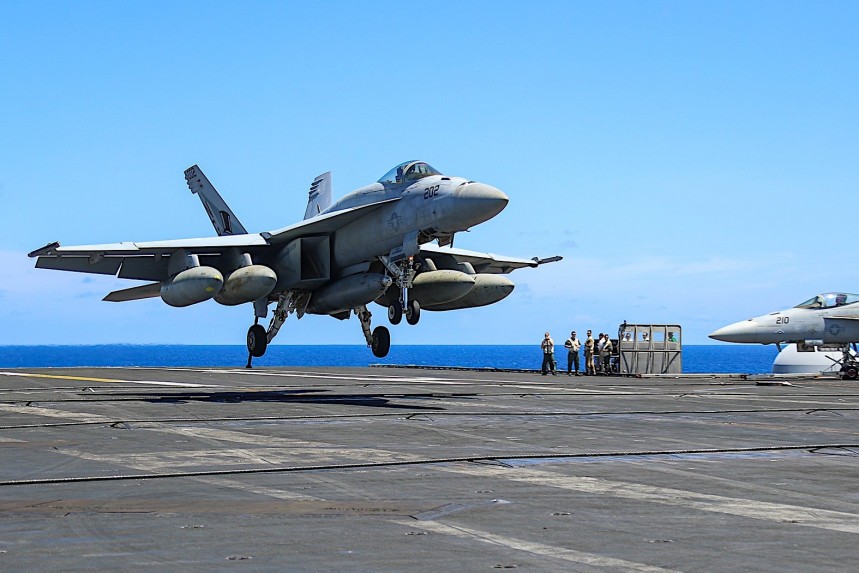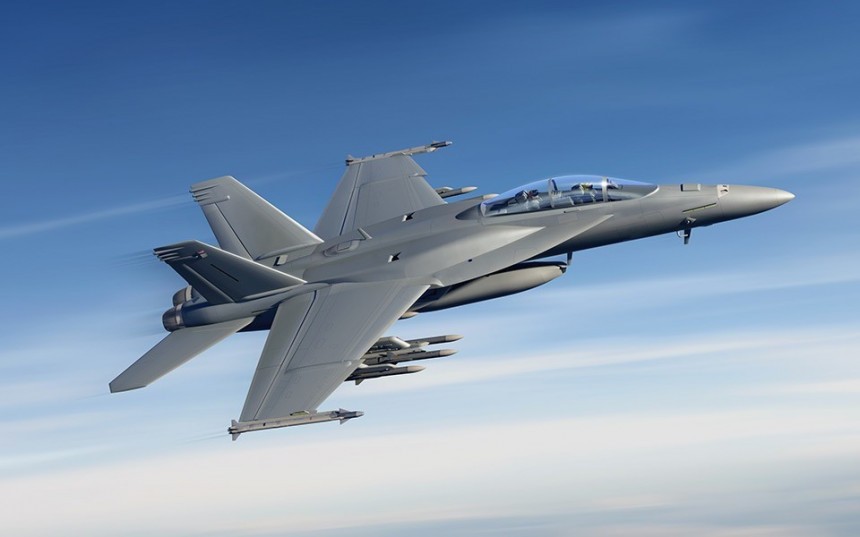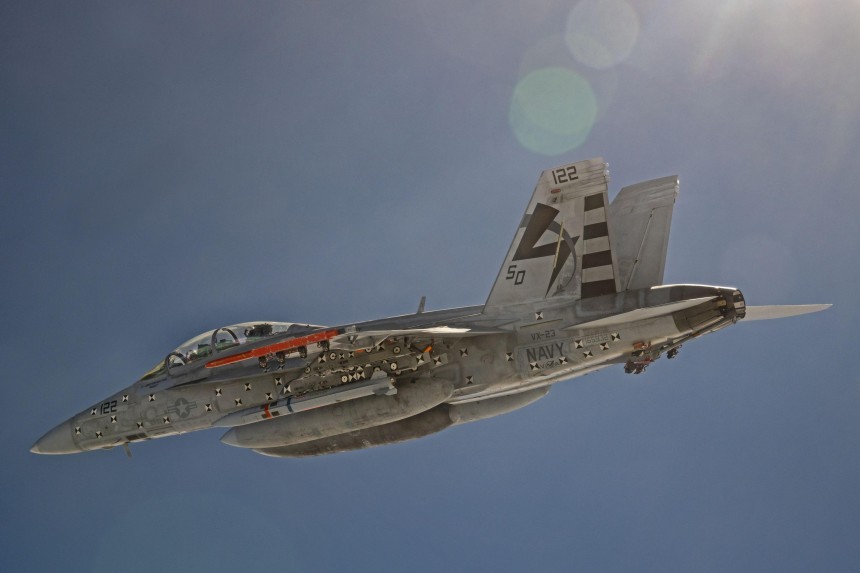Round about 17 years ago, aviation fans across the web hailed the retirement of the Grumman F-14 Tomcat as one of the worst tactical decisions the U.S. Navy's made in decades. This was doubly so. Because the F-35 would usurp the Tomcat's role, a plane many armchair av-geeks despise, less than a decade later.
Oh, jeez, we wonder how these people will react to the F/A-18 Super Hornet going dodo. Of course, the Super Hornet's slightly less spicy older brothers, the "regular" Hornets, have already been retired from U.S. Navy service for a few years.
That won't stop a select group of people from claiming the Navy would have been better off sticking with legacy aircraft like the Hornet. Well, we hate to burst people's bubbles. But the notion the F-35 is a bad airplane and that the Super Hornet would be better long-term is simply asinine.
Regarding technological advancement of carrier-based fighter jets, the McDonnell Douglas F-18 Hornet and F/A-18 Super Hornet were more evolutionary than revolutionary, unlike the swing-wing sci-fi machine that was the F-14. As the spiritual successor to the Northrop YF-17 Cobra built to compete with the F-16, the F-18 tuned this airframe from a failure into a big win for McDonnell-Douglas.
In most regards, the standard F-18 was one of the most advanced, capable, and dependable carrier-based jet fighters of the late 20th century. But there was a problem, the standard Hornet's combat radius wasn't all that impressive. What was needed was a slightly enlarged F-18 airframe to accommodate a larger fuel load and better engines. The first Navy production order for what was initially dubbed the Hornet II was placed in 1992 and flew for the first time in November 1995.
To say the Super Hornet formed the backbone of the U.S. Navy's aerial fleet defense is nothing short of an understatement. Especially after the F-14 Tomcat's retirement in 2006, the Super Hornet carried the burden alone for the Navy until the F-35C arrived on the scene in February 2019. In a way, this has led the Super Hornet to have a very special place in the hearts of aviation fans. A connection that might lead to some dubious assumptions about its capabilities.
You see, there's a stark divide between those who wholeheartedly accept gen-V stealth fighters and those who write them off as overly-expensive wastes of taxpayer money. The truth of the matter is the battlefields of modern conflicts are about to look dramatically different from what they've looked like in the last 40 years.
In a modern conflict between the U.S. and an "equally" matched adversary like China, jet fighters are bound to be classed in two separate camps. These two camps will be the all-powerful stealth fighters and non-stealthy cannon fodder. Unfortunately, the F/A-18 is bound to fall into the latter category.
Even as countermeasures to stealth aircraft grow more robust, the difference between an airframe with integrated radar stealth and those which don't could very well be the difference between life and death in future wars, more or less guaranteed to pop off in the next 20 years. The notion that simplicity and world-class maneuverability are the only factors in who wins a dogfight may have been sound in the late 1960s. But in 2023, that line of thinking is more outdated than 8-track tapes.
Even so, there are still elements within the orbit of the Pentagon's inner circle who have a vested interest in legacy airframes taking precedence over newer vehicles. Former members of a joint Air Force and civilian defense analyst group who helped develop the F-15 and F-16 back in the 60s still held considerable sway with the media for years after the project. This reformist movement is dubbed the Fighter Mafia in the media.
Before their respective deaths, leading reformist members like Pierre Sprey, John Boyd, and Thomas P. Christie lambasted the F-35 as an overly complex and expensive machine that'd get their rear ends handed to them by legacy airframes like the Mirage III and the MiG-21 in a dogfight.
Yeah, we're not so sure about that. That hasn't stopped a slew of news articles and general pieces of media from Forbes to the Wall Street Journal from hailing the F-35 in all its forms as a failure of an airplane before the things have even seen real combat. More to the point, they like to proclaim that legacy airframes, the F/A-18 included, would be a better choice to have in service.
Never mind that Pierre Sprey once barged into an Air Force meeting demanding to have the Super Hornet's Air Force counterpart, the F-15 scrapped in favor of his own design called the F-XX. For some context, Sprey's design lacked a radar, had an unencrypted radio, and forwent missile pylons in favor of the A-10s GAU-8 Avenger cannon as its only armament.
Even if the focal point of the Fighter Mafia's ire was often directed at the Air Force's F-15, this same logic is often applied to the F/A-18 as well. But, however you try and slice it, the logical fallacy that ancient gen-III and gen-IV aircraft are ultimately more effective than modern gen-V stealth fighters doesn't add up when held to real scrutiny. But the truth of the matter is the F/A-18's lineage won't be replaced outright by the F-35 at all.
Rather, the Super Hornet is due to be replaced starting in the 2030s by the U.S. Navy's F/A-XX program. An initiative to bring novel sixth-generation fighter technology to the Navy while the separate Next Generation Air Dominance program handles the Air Force and the F-22 Raptor. Safe to say, the Fighter Mafia reformers would have had a field day if they were privy to any of the technology on the table for gen-VI fighters had they lived to see it fly.
If nothing else, the sun-setting of the F-18's entire lineage sometime after 2025 gives a great opportunity to examine the complex, deep-seated, possibly even parasocial relationships life-long fans of warbirds have with their favorite aircraft. Though many favor the sleeker, swing-wing F-14 Tomcat, the Hornet/Super Hornet was still the pin-up poster darling for countless av-geeks for decades.
It's incredibly sad when a pin-up poster darling vehicle is retired. Whether it's sports cars, superbikes, or even jet fighters, just ask any av-geek how they felt when the F-14 was retired. But come on now, no airplane can fly forever. Not the F-15, not the F-22, and especially not the Super Hornet.
The time will soon be upon us to say goodbye to the F/A-18 in its entirety. When that day comes, rest easy, knowing it's being replaced by the greatest hardware ever devised.
That won't stop a select group of people from claiming the Navy would have been better off sticking with legacy aircraft like the Hornet. Well, we hate to burst people's bubbles. But the notion the F-35 is a bad airplane and that the Super Hornet would be better long-term is simply asinine.
Regarding technological advancement of carrier-based fighter jets, the McDonnell Douglas F-18 Hornet and F/A-18 Super Hornet were more evolutionary than revolutionary, unlike the swing-wing sci-fi machine that was the F-14. As the spiritual successor to the Northrop YF-17 Cobra built to compete with the F-16, the F-18 tuned this airframe from a failure into a big win for McDonnell-Douglas.
In most regards, the standard F-18 was one of the most advanced, capable, and dependable carrier-based jet fighters of the late 20th century. But there was a problem, the standard Hornet's combat radius wasn't all that impressive. What was needed was a slightly enlarged F-18 airframe to accommodate a larger fuel load and better engines. The first Navy production order for what was initially dubbed the Hornet II was placed in 1992 and flew for the first time in November 1995.
You see, there's a stark divide between those who wholeheartedly accept gen-V stealth fighters and those who write them off as overly-expensive wastes of taxpayer money. The truth of the matter is the battlefields of modern conflicts are about to look dramatically different from what they've looked like in the last 40 years.
In a modern conflict between the U.S. and an "equally" matched adversary like China, jet fighters are bound to be classed in two separate camps. These two camps will be the all-powerful stealth fighters and non-stealthy cannon fodder. Unfortunately, the F/A-18 is bound to fall into the latter category.
Even as countermeasures to stealth aircraft grow more robust, the difference between an airframe with integrated radar stealth and those which don't could very well be the difference between life and death in future wars, more or less guaranteed to pop off in the next 20 years. The notion that simplicity and world-class maneuverability are the only factors in who wins a dogfight may have been sound in the late 1960s. But in 2023, that line of thinking is more outdated than 8-track tapes.
Before their respective deaths, leading reformist members like Pierre Sprey, John Boyd, and Thomas P. Christie lambasted the F-35 as an overly complex and expensive machine that'd get their rear ends handed to them by legacy airframes like the Mirage III and the MiG-21 in a dogfight.
Yeah, we're not so sure about that. That hasn't stopped a slew of news articles and general pieces of media from Forbes to the Wall Street Journal from hailing the F-35 in all its forms as a failure of an airplane before the things have even seen real combat. More to the point, they like to proclaim that legacy airframes, the F/A-18 included, would be a better choice to have in service.
Never mind that Pierre Sprey once barged into an Air Force meeting demanding to have the Super Hornet's Air Force counterpart, the F-15 scrapped in favor of his own design called the F-XX. For some context, Sprey's design lacked a radar, had an unencrypted radio, and forwent missile pylons in favor of the A-10s GAU-8 Avenger cannon as its only armament.
Rather, the Super Hornet is due to be replaced starting in the 2030s by the U.S. Navy's F/A-XX program. An initiative to bring novel sixth-generation fighter technology to the Navy while the separate Next Generation Air Dominance program handles the Air Force and the F-22 Raptor. Safe to say, the Fighter Mafia reformers would have had a field day if they were privy to any of the technology on the table for gen-VI fighters had they lived to see it fly.
If nothing else, the sun-setting of the F-18's entire lineage sometime after 2025 gives a great opportunity to examine the complex, deep-seated, possibly even parasocial relationships life-long fans of warbirds have with their favorite aircraft. Though many favor the sleeker, swing-wing F-14 Tomcat, the Hornet/Super Hornet was still the pin-up poster darling for countless av-geeks for decades.
It's incredibly sad when a pin-up poster darling vehicle is retired. Whether it's sports cars, superbikes, or even jet fighters, just ask any av-geek how they felt when the F-14 was retired. But come on now, no airplane can fly forever. Not the F-15, not the F-22, and especially not the Super Hornet.
